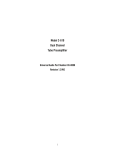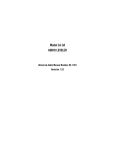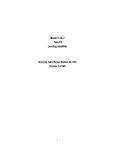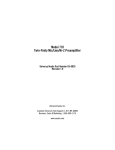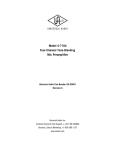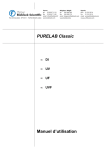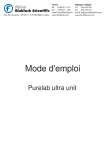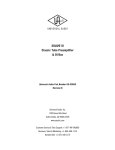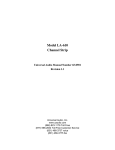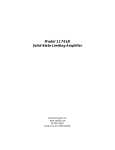Download Universal Audio 6176 Operating instructions
Transcript
Model 4110/8110 Four and Eight Channel Precision Microphone Preamplifiers Universal Audio Manual Number 65-1001 Revision 1.00 The 4110 and 8110 Preamps Thank you for choosing the Universal Audio Precision Microphone Preamplifier The X110 series is based on the discrete class A analog technology from Universal Audio’s award winning 2192 converters. Fidelity The X110 series preamps offer totally transparent, crystal clear natural fidelity as well as flexible control over the input impedance and transformer saturation resulting in increased flexibility making it a great choice for a wide variety of applications. The X110 series offers a complimentary tool to be used along side our 2-610 tube preamps and the classic overdrive character of our 2108 solid-state preamps. The X110 analog signal path uses DC-coupled, matched-FET, all discrete Class-A circuitry, resulting in ultra-low noise, excellent transient response and unmatched sound. Capacitors are not used in the signal path in order to avoid degradation in audio quality and phase distortion while increasing the overall image stability. Our no-compromises design approach and extensive history in analog and digital circuit design ensure your signals are totally accurate and have the highest possible fidelity. “SHAPE” Control The X110 handles multi-channel applications and excels among the best modern, ultra-clean units. In addition, it also offers enough sonic variation to create the “character” UA mic preamps are so known for, effectively maximizing multi-channel functionality. Every channel of the X110 Preamp features dedicated Gain and Level controls, dual input Impedance Selection, and a 3-way "SHAPE" switch offering variable signal-paths for maximum sonic versatility. While the OFF position is perfect for a modern preamp sound with no coloration, Position 1 (Vintage) borrows from vintage circuits and adds transformer saturation, enhancing harmonic content. Position 2 (Saturate) maintains transformer color and adds soft limiting, particularly useful on transient rich and dynamic sounds. Features • DC-coupled, matched-FET, all discrete Class-A, no-compromises analog signal path • Ultra-low noise • High Gain • Pristine signal path uses no capacitors reducing phase distortion and avoiding degradation in audio quality and image stability • SHAPE Control offers flexible sonics, providing variations of harmonic color, subtle compression and soft limiting ii • Dual impedance input transformer • Separate Gain and Level controls for maximum signal to noise control and flexibility • Multi-segment LED bar graph output metering on each channel • Separate 3 stage input status LED on each channel • Pad, Phase, Low Cut and +48 V all with separate backlit switches • Line level inputs on every channel • Rugged 3U rack mount chassis In addition to the 4110 & 8110 Preamps, Universal Audio has released reproductions of the classic Teletronix LA-2A Leveling Amplifier and 1176LN Limiter as well as the 610 tube preamp and 2108 microphone preamplifier, which are based on preamps used in legend Bill Putnam Sr.’s custom consoles. Universal Audio also creates software emulations of our vintage hardware that run on our UAD-1 DSP card as well as Digidesign’s Pro Tools platform. All of these products are designed to meet the demands of the modern recording studio, yet retain the character and quality of vintage equipment. See more at www.uaudio.com including the award winning 6176 channel strip, the new LA610 all-tube channel strip, and 2192 Master Audio Interface A/D and D/A. iii IMPORTANT SAFETY INSTRUCTIONS Before using this unit, be sure to carefully read the applicable items of these operating instructions and the safety suggestions. Afterwards keep them handy for future reference. Take special care to follow the warnings indicated on the unit, as well as in the operating instructions. 1. 2. 3. 4. 5. 6. 7. 8. Water and Moisture – Do not use the unit near any source of water or in excessively moist environments. Object and Liquid Entry – Care should be taken so that objects do not fall, and liquids are not spilled, into the enclosure through openings. Ventilation – When installing the unit in a rack or any other location, be sure there is adequate ventilation. Improper ventilation will cause overheating, and can damage the unit. Heat – The unit should be situated away from heat sources, or other equipment that produce heat. Power Sources – The unit should be connected to a power supply only of the type described in the operating instructions, or as marked on the unit. Power Cord Protection – AC power supply cords should be routed so that they are not likely to be walked on or pinched by items placed upon or against them. Pay particular attention to cords at plugs, convenience receptacles, and the point where they exit from the unit. Never take hold of the plug or cord if your hand is wet. Always grasp the plug body when connecting or disconnecting it. Grounding of the Plug – This unit is equipped with a 3wire grounding type plug, a plug having a third (grounding) pin. This plug will only fit into a groundingtype power outlet. This is a safety feature. If you are unable to insert the plug into the outlet, contact your electrician to replace your obsolete outlet. Do not defeat the purpose of the grounding-type plug. Carts and Stands – The unit should be used only with a cart or stand that is recommended by the manufacturer. The unit and cart combination should be moved with care. Quick stops, excessive force and uneven surfaces may cause the unit and cart combination to overturn. 9. Wall Or Ceiling Mount – The unit should be mounted to a wall or ceiling only as recommended by the manufacturer. 10. Cleaning – The unit should be cleaned only as recommended by the manufacturer. 11. Nonuse Periods – The AC power supply cord of the unit should be unplugged from the AC outlet when left unused for a long period of time. 12. Damage Requiring Service – The unit should be serviced by a qualified service personnel when: a) The AC power supply cord or the plug has been damaged: or b) Objects have fallen or liquid has been spilled into the unit; or c) The unit has been exposed to rain; or d) The unit does not operate normally or exhibits a marked change in performance; or e) The unit has been dropped, or the enclosure damaged. 13. Servicing – The user should not attempt to service the unit beyond that described in the operating instructions. All other servicing should be referred to qualified service personnel. iv Notice This manual provides general information, preparation for use, installation and operating instructions for the Universal Audio 4110 and 8110 preamps. The information contained in this manual is subject to change without notice. Universal Audio, Inc. makes no warranties of any kind with regard to this manual, including, but not limited to, the implied warranties of merchantability and fitness for a particular purpose. Universal Audio, Inc. shall not be liable for errors contained herein or direct, indirect, special, incidental, or consequential damages in connection with the furnishing, performance, or use of this material. Copyright © 2005 Universal Audio, Inc. All rights reserved. This manual and any associated software, artwork, product designs, and design concepts are subject to copyright protection. No part of this document may be reproduced, in any form, without prior written permission of Universal Audio, Inc. Trademarks LA-2A, 1176LN, 2-610, 2108, 6176, 2-1176, LA-610, 4110, 8110, 2192, UAD-1 and the Universal Audio, Inc. logo are trademarks of Universal Audio, Inc. Other company and product names mentioned herein are trademarks of their respective companies. v Table Of Contents Specifications..................................................................................................................... 1 Operating Instructions........................................................................................................ 3 Front Panel ............................................................................................................... 3 Rotary Controls ......................................................................................................... 4 Input Select ............................................................................................. 4 Gain......................................................................................................... 5 Level ........................................................................................................ 5 Function Switches..................................................................................................... 6 Polarity .................................................................................................... 6 Low Cut.................................................................................................... 6 Mic Pad.................................................................................................... 6 +48 V (Phantom Power) .......................................................................... 6 Output Meter............................................................................................................. 6 Input Meter ............................................................................................................... 6 SHAPE Control Switch ............................................................................................... 7 Power Switch ............................................................................................................ 7 Rear Panel .......................................................................................................................... 8 Input/Output............................................................................................................. 8 AC Power .................................................................................................................. 8 Fuse/Mains ............................................................................................................... 8 Voltage Select........................................................................................................... 9 Historical Notes ................................................................................................................ 10 The 610 Preamp...................................................................................................... 10 The 1176 and LA-2A Compressors.......................................................................... 11 The 1176................................................................................................................. 11 The LA-2A ............................................................................................................... 12 vi 4110 / 8110 Performance Specifications Mic Input Impedance………………………………………………………………....500 ohms, 2k ohms Balanced Line Input Impedance……………………………………………………………….6.5k ohms Instrument Input Impedance………………………………………………………..47k ohms, 2.2M ohms Max Mic Input Level, No Pad………………………………………………..…+3 dBu, 0.1% THD+N Ratio Max Mic Input Level With Pad………………………………………...………+14 dBu, 0.1% THD+N Ratio Max Instrument Input Level…………………………………………………..+25 dBu, 0.1% THD+N Ratio Max Output Level into 600 ohms……………………………………………..…+23 dBu, 1% THD+N Ratio Max Output Level into 100k ohms…………………………………………..…+30 dBu, 0.2% THD+N Ratio Internal Output Impedance……………………………………...………………………….……90 ohms Recommended Minimum Load…………….……………………………………………………600 ohms Mic In Freq. Response …………………………………………………..……10 Hz to 50 kHz, +/- 0.1 dB Mic –3dB roll off point, 150 ohm source…………………………………………………..………100 kHz Line In Freq. Response, 600ohm source…………………………………………10 Hz to 30 kHz, +/- 0.2 dB Line In –3dB roll off point, 600 ohm source …………………………………………………...……90 kHz Instrument In Freq. Response (2.2M input)………………...……………………10 Hz to 70 kHz, +/- 0.1 dB Instrument In –1dB roll off point…………………………………………………………………200 kHz Low Cut –3dB roll off point………………………………………………………..………………100 Hz Max Gain Line Input………………………………………………………………………………47 dB Max Gain Mic Input (SHAPE off)……………………………………72 dB (2k Ω input) 74 dB (500 Ω input) Max Gain Mic Input (SHAPE = 1)………………………………...…74 dB (2k Ω input) 78 dB (500 Ω input) Mic Equivalent Input Noise, (EIN)………………………………………………………………-128 dBu Mic Input THD+N ratio ………………………………-83 dB (0.007%), 20 to 20kHz (-30dBu in, +4dBu out) Residual Noise, 150 ohm source………………………………………92 dBu, 20 to 20 kHz (non-weighted) 1 Output Meter Reference Levels Red…………………………………………….…………………………...………..+10 dBu Yellow………………………………………………………………………...……….+4 dBu Green (upper)……………………………………………………………….…………..-2 dBu Green (lower)…………………………………………………………………………..-10 dBu Input Meter Reference Levels Red………………………………………………………..………1.0% THD+N Ratio (40V pk-pk at JP1) Orange………………………………………………………………2% THD+N Ratio (20V pk-pk at JP1) Green…………………………………………………………….0.07% THD+N Ratio (12V pk-pk at JP1) General Power Requirements…………………………………………………………..…100-240 VAC (50-60 Hz) Max Power Consumption, 4110………………………………………………………………………55W Max Power Consumption, 8110………………………………………………………………………93W Dimensions.…………………………………………………………….…..(H) 5.25” X (W) 19” X (D) 12” Weight, 4110.…………………………………………………………….…… 12 lbs. (Boxed,17.5 lbs.) Weight, 8110.……………………………………………………….………….15 lbs. (Boxed,20.5 lbs.) 2 Preamp Operating Instructions The 4110 and the 8110 have exactly the same circuits. The front panel controls are the same and the following operating instructions apply to either product with one exception; the 4110 provides Hi-Z instrument inputs on all four channels. The 8110 does not provide Hi-Z instrument inputs. 4110 Front Panel 1 5 4 HI-Z INPUTS 2 6 3 1 1 LEVEL 2 1 4 SHAPE INPUT 2 5 OFF 6 3 7 1 7 1 10 LINE 500 2.0M 6 1 500 MIC 2.0K 2.0M 500 PAD 4110 PRECISION CLASS A PREAMPLIFIER 6 7 8 1 10 LINE 5 3 9 0 GAIN HI-Z 47K UNIVERSAL AUDIO INPUT 2 2 9 0 1 4 8 10 LINE OFF 7 GAIN MIC 2.0K 5 OUTPUT SHAPE INPUT 2 2 9 0 HI-Z 47K 10 LEVEL OUTPUT 3 8 GAIN 1 4 2 9 0 MIC 2.0K OFF 6 3 8 9 0 SHAPE INPUT 2 5 4 2 3 1 8 1 10 LEVEL OUTPUT 7 2 9 0 LEVEL OUTPUT SHAPE OFF 1 6 3 8 10 5 4 7 2 9 0 4 6 3 8 10 5 4 7 2 9 0 3 6 3 8 1 5 4 7 2 10 GAIN HI-Z 47K MIC 2.0K 2.0M LINE HI-Z 47K 500 PAD ON (I) 2.0M PAD PAD 4 OFF (0) INPUT INPUT +48V INPUT +48V INPUT +48V +48V Figure 1: 4110 Front Panel 8110 Front Panel 1 5 4 2 6 3 0 LEVEL LEVEL OUTPUT SHAPE OFF 4 1 OFF 6 3 4 7 2 MIC 2.0K 4 LINE MIC 2.0K LINE MIC 2.0K LINE MIC 2.0K LINE 8 MIC 2.0K OUTPUT 4 MIC 2.0K MIC 2.0K UNIVERSAL AUDIO INPUT 2 5 6 8110 PRECISION CLASS A PREAMPLIFIER 7 2 8 1 10 9 0 GAIN LINE 1 3 9 0 500 10 GAIN LINE MIC 2.0K 500 PAD OFF 4 8 1 10 OUTPUT SHAPE INPUT 6 7 GAIN LINE LEVEL OUTPUT 2 5 2 9 0 1 3 8 1 500 PAD OFF 6 2 10 10 SHAPE INPUT 2 5 9 0 LEVEL 7 GAIN 500 PAD 1 3 9 0 GAIN 500 PAD 4 7 1 10 OFF 8 1 10 SHAPE INPUT 6 2 9 0 LEVEL OUTPUT 2 5 3 8 1 1 4 2 10 OFF 0 7 2 9 10 SHAPE INPUT 6 7 GAIN 500 PAD LEVEL OUTPUT 2 5 3 9 0 1 4 8 1 10 OFF 0 6 3 8 1 5 4 7 2 9 10 SHAPE INPUT 6 7 GAIN 500 OUTPUT 2 5 2 9 0 1 3 8 1 10 OFF 7 GAIN LEVEL SHAPE INPUT 6 0 8 6 3 8 1 5 4 7 2 9 10 7 6 3 8 1 5 4 7 2 9 0 LEVEL OUTPUT 2 5 2 9 0 1 3 8 1 10 SHAPE INPUT 2 5 0 6 6 3 8 1 5 4 7 2 9 10 5 6 3 8 1 5 4 7 2 9 10 4 6 3 8 1 5 4 7 2 9 0 3 6 3 8 1 5 4 7 2 LINE ON (I) 500 PAD PAD PAD OFF (0) INPUT +48V INPUT +48V INPUT +48V INPUT +48V INPUT +48V INPUT Figure 2: 8110 Front Panel 3 +48V INPUT +48V INPUT +48V 4110 & 8110 Front Panel Channel Blocks 4 5 4 8 6 3 7 2 8 1 7 1 9 8 10 0 LEVEL 10 LEVEL OUTPUT SHAPE OFF 4 1 OFF 6 3 4 7 2 8 1 500 6 7 1 9 8 10 LINE INPUT 2 5 3 0 GAIN MIC 2.0K 1 2 9 0 OUTPUT SHAPE INPUT 2 5 6 3 2 9 0 5 4 10 GAIN HI-Z 47K MIC 2.0K 2.0M LINE 500 PAD INPUT PAD INPUT +48V +48V Figure 3: 4110 & 8110 Front Panel Channel Blocks Note: The 8110 Front Panel Controls are identical to the 4110 except the Hi-Z Input position is eliminated on the INPUT control knob. Rotary Controls Input Select The Input Select switch is the bottom knob on the left side of the channel block. It determines which input is active: Mic, Line, or Hi-Z. Within both the Mic and Hi-Z areas, the switch includes two settings to select different input impedances. • Mic: Selects the signal from the rear-panel, balanced, MIC INPUT XLR connector. The impedance for the MIC INPUT can be set to 500Ω or 2KΩ. Switching between these two positions while listening to a connected microphone may reveal a different tonal quality and / or gain. A typical mic preamplifier should have an input impedance equal to about 10 times the mic output impedance. For example, if your mic has an output impedance between 150Ω and 200Ω, set the switch to the 2K position. However, since making music is not necessarily about adhering to technical specifications, feel free to experiment with the settings to attain the desired sound. You will not harm your microphone or the preamp. • Line: Selects the signal from the rear-panel, balanced, LINE INPUT XLR connector. LINE INPUT has an input impedance of 6.5 k ohms and is intended to accommodate mixers, tape machines, other 4 mic preamps, keyboards, sound modules and drum machines or any device with a line level output. The 4110/8110 may be used as a “tone box” in this configuration, offering a variety of sonic colors based on the front panel control settings. • Hi-Z: Selects the signal from the front panel (4110 only), unbalanced Hi-Z 1/4”connector. This input can have an input impedance of 47K Ω or 2.2MΩ and is intended for bass, guitar or any instrument with a magnetic or acoustic transducer pickup. The 47KΩ setting is best suited for 10 dBv level signals, typically found on active basses and guitars. The 2.2MΩ setting is appropriate for instruments with passive pickup systems. Since an instrument’s output impedance may be somewhere between the active and passive levels, feel free to experiment to achieve the best sound at the desired level. Gain The Gain control is the middle knob on the left side of the channel block. This knob adjusts the gain of the input stage. Turning the knob clockwise increases the gain. This control should be at higher settings when using low output microphones, such as ribbon mics and some older dynamic mics. The knob is continuously variable, the 0-10 front panel settings are relative scale markings and do not represent any specific dB level. In addition to changing the volume, the Gain control will change the preamp tone. Less Gain and more Level will create a cleaner tone, while more Gain and less Level will yield a warmer tone. Gain is also a factor when using the SHAPE control. More on this in the section about SHAPE on page 7. Level The Level control is the top knob on the left side of the channel block. This is the channel’s master volume control and determines the amount of signal from the preamplifier’s Line Output. The knob is continuously variable, the 0-10 front panel settings are relative scale markings and do not represent any specific dB level. 5 Function Switches (backlit push buttons) Polarity The Polarity switch is the top switch in the column of four round push buttons located on the lower right side of the channel block. The polarity switch will light up when enabled and is labeled with the symbol: “∅”. When off, pin 2 of the LINE OUTPUT is hot (positive). When the switch is enabled, pin 3 is hot (positive). Normally the switch should be off and only enabled when it is desirable to reverse the polarity of the Line Output signal. Low Cut The Low Cut switch is the second switch down in the column of four round push buttons located on the lower right side of the channel block. The switch will light up when enabled and is labeled with the symbol: “ ” When enabled the input signal will pass through a 100Hz 6dB per octave filter. Mic Pad The PAD switch is the third switch down in the column of four round push buttons located on the lower right side of the channel block. The switch will light up when enabled and will attenuate the Mic input level by 15dB. When undesired distortion is present at low gain levels it is recommended to engage the Pad switch then turn up the Gain and level controls as needed. The Mic Pad has no effect on Instrument and Line In signals +48 V (Phantom Power) The +48 V switch is the bottom switch in the column of four round push buttons located on the lower right side of the channel block. The switch will light up when enabled and 48 volts will be supplied to the Mic input jack. Most modern condenser mics require phantom voltage to operate and we recommend checking the requirements of your microphones before connecting them. It is good practice to keep phantom power off when it is not required. To prevent loud transients, make sure the phantom power is off when connecting or disconnecting microphones. Output Meter The Output Meter is a three color LED bar graph located at the top right corner of the channel block. Input Meter The Input Meter is a single round tri-color LED located below the Output Meter on the right side of the channel block. When nominal signal levels are present the LED will be green. The color will change to yellow and then red, as higher levels are present in the input stage (see specs on page 2). The Input Meter may be a helpful indicator when adjusting the Gain control, using the PAD function and when using the SHAPE control toggle switch. 6 SHAPE Control Switch The SHAPE control is a three position mini toggle switch located just below the top rotary knob on the left side of the channel block. NOTE: Only SHAPE position 2 has effect on the 4110 Instrument Input as the input transformer is only used for Mic & Line inputs. Position OFF This position selects the purest signal path, and is called the Modern position; Clean, clear, full bandwidth that is distortion free. Position 1 This position selects transformer loading, and is called the Vintage position. This setting changes the loading on the mic/line input transformer to provide more of that “iron” sound popular in vintage transformer-coupled preamps. This could be described as warmer and more present, with increased sensitivity to the microphone’s impedance curve; A bit of harmonic coloration enhancing midfrequency tone and presence, or a more three dimensional character. Higher Gain settings will increase these characteristics. Position 2 This position is the same as position 1 with the addition of a soft limiting circuit. We call this position Saturate. This setting uses the same transformer loading as Position 1, but also adds additional loading to the first stage preamp, which is perfect for smoothing out transients without clipping. When using this position the input signal is naturally lowered. Experiment with higher Gain settings to achieve greater “saturation” when using this mode. Power Switch The Main power switch is located on the far right side of the front panel. The up position applies power to the preamp and lights a blue jewel lamp located above the switch. Note: There is a short power cycle before the preamp is enabled. This delay is used to auto-calibrate the preamp channels. 7 4110 / 8110 Rear Panels On the left, AC Power input receptacle. On the right, the MIC INPUT, LINE INPUT, and LINE OUTPUT XLR connectors. These connectors are discussed in the following sections. 4 3 2 1 MIC IN MIC IN LINE IN LINE IN POWER IN: 100-240V 50/60Hz FUSE RATING: T 4A 250V REPLACE FUSE WITH SAME RATING AND TYPE ONLY! LINE OUT LINE OUT 4 3 2 UNIVERSAL AUDIO, INC SANTA CRUZ, CALIF. - U.S.A. 1 Figure 4: 4110 Rear Chassis 8 POWER IN: 100-240V 50/60Hz FUSE RATING: T 4A 250V REPLACE FUSE WITH SAME RATING AND TYPE ONLY! UNIVERSAL AUDIO, INC SANTA CRUZ, CALIF. - U.S.A. 7 6 5 4 3 2 1 MIC IN MIC IN LINE IN LINE IN LINE OUT LINE OUT 8 7 6 5 4 3 2 1 Figure 5: 8110 Rear Chassis Input/Output Standard XLR input and output connectors are provided on the rear panel. Pin 2 is wired positive (hot) on the LINE and MIC INPUTS. Pin 2 is positive on the LINE OUTPUT when the front panel Polarity push button switch is out (Off). Pin 3 is positive on the LINE OUTPUT when the Polarity push button switch is pushed in and lit up (OUT ∅). AC Power The 4110 / 8110 use standard, detachable IEC power cables. Fuse/Mains There is no user accessible fuse for the 4110 / 8110. The units have an internal power supply circuit board with its own fuse. 8 Voltage Select The 4110 / 8110 contains a universal auto-sensing, filtered, multi-stage regulated power supply, which supports 100-240VAC and 50-60Hz power for trouble-free operation worldwide. No switch setting is required when changing from 115 to 230 volt use or vice versa. 9 Historical Notes Bill Putnam was awarded the 2000 Technical Grammy for his multiple contributions to the recording industry. He was highly regarded as a recording engineer, studio designer/operator and inventor. Putnam was considered a favorite of musical icons including Frank Sinatra, Nat King Cole, Ray Charles, Duke Ellington, Ella Fitzgerald and many, many more. The studios he designed and operated were known for their sound and were an experimentation ground for his continuing desire to push the envelope. Universal Recording in Chicago, United and Western in Los Angeles (now Ocean Way and Cello) all preserve elements of his room designs. The companies Putnam started, Universal Audio, Studio Electronics, and UREI, built products that are still in regular use decades after their development. In 1999 Bill Jr. and James Putnam re-launched Universal Audio and merged with Kind of Loud technologies – a leading audio software company – with two goals: Reproduce classic analog recording equipment designed by their father and his colleagues, research and design new recording tools in the spirit of vintage analog technology. Today Universal Audio is fulfilling that goal, bridging the worlds of vintage analog and DSP technology in a creative atmosphere where musicians, audio engineers, analog designers and DSP engineers intermingle and exchange ideas every day. Analog or digital, UA remains committed to the “hand assembled” ideal that has been forgotten by many audio manufacturers. Whatever the endeavor, every project taken on by the UA team is driven by its historical roots and a desire to wed classic analog technology with the demands of the modern digital studio. The 610 Preamp The 2-610 was inspired by the Putnam-designed 610 console built in 1960 for his United Recording facility at 6050 Sunset Boulevard in Hollywood (now Ocean Way). As was the case with most of Putnam’s innovations, the 610 was the pragmatic upshot of a recurring problem in the studio: how to fix a console without interrupting a session. The traditional console of the time was a one-piece control surface with all components connected via patch cords. If a problem occurred, the session came to a halt while the console was dismantled. Putnam’s solution was to build a mic-pre with gain control, echo send and adjustable EQ on one modular chassis using a printed circuit board. While modular consoles are commonplace today, the 610 was quite a breakthrough at the time. While the 610 was designed for practical reasons, it was aesthetic appeal that made it popular with the recording artists who frequented United and Western in the 60’s. The character of the mic-pre in particular made it favorite of engineers like Bruce Swedien, Bruce Botnick, Lee Hershberg and Jack Joseph Puig; and artists including Sarah Vaughan, Frank Sinatra, Ray Charles, and The Beach Boys. Swedien describes the character of the preamp as “clear and open” and “very musical”. Studios 2 and 3 at Western, which featured the 610 console, were the site of many classic recordings of the 60’s, including the Mamas and the Papas (Bones Howe), Up, Up and Away by the Fifth Dimension, Herb Alpert, Sergio Mendes (Bruce Botnick), and of course Pet Sounds. 10 Legendary engineer Wally Heider, manager of remote recording at United, used his 610 console to record many live recordings including Peter, Paul and Mary “In Concert” (1964), Wes Montgomery’s “Full House” (1962), and all of the Smothers Brothers Live albums. Heider’s console was later acquired by Paul McManus in 1987, who spent a decade restoring it. [We thank Paul for his efforts and his contribution to our efforts to trace the history of the 610.] At least one 610 module is still in use at Ocean Way. Allen Sides, who purchased the studio from Putnam to open Ocean Way, personally traveled to Hawaii to collect the 610 console that was used to record the live “Hawaii Calls” broadcasts. Jack Joseph Puig has been ensconced in Studio A with the 610 (and a stunning collection of vintage gear) where he has applied the vintage touch to acts including Beck, Hole, Counting Crows, Goo Goo Dolls, No Doubt, Green Day and Jellyfish. The 1176LN Limiting Amplifier and LA-2A Leveling Amplifier The LA-2A and 1176 compressor/limiters long ago achieved classic status. They're a given in almost any studio in the world — relied upon daily by engineers whose styles range from rock to rap, classical to country and everything in between. With so many newer products on the market to choose from, it's worth looking at the reasons why these classics remain a necessary part of any professional studio's outboard equipment collection. The basic concept of a compressor/limiter, is of course, relatively simple. It's a device in which the gain of a circuit is automatically adjusted using a predetermined ratio that acts in response to the input signal level. A compressor/limiter "rides gain" like a recording engineer does by hand with the fader of a console: it keeps the volume up during softer sections and brings it down when the signal gets louder. The dynamic processing that occurs at ratios below 10 or 12 to one is generally referred to as compression; above that it's known as limiting. Modern day compressors offer a great degree of programmability and flexibility while older devices such as the 1176 and the LA-2A are more straightforward in their design. Perhaps it is this fact that has contributed to their appealing sound and the longevity of their popularity. The 1176 LN The original Universal Audio 1176LN was a major breakthrough in limiter technology – the first true peak limiter with all transistor circuitry offering superior performance and a signature sound. Evolved from the popular Universal Audio 175 and 176 vacuum tube limiters, the 1176LN retained the proven qualities of these industry leaders, and set the standard for all limiters to follow. It was Bill Putnam himself who, in 1966, was responsible for the initial design of the 1176. Its circuit was rooted in the 1108 preamplifier, which was also designed by Putnam. As is evident from entries and schematics in his design notebook, he experimented with the recently developed Field Effect Transistor (F.E.T.) in various configurations to control the gain reduction in the circuit. He began using F.E.T.s as voltage variable resistors, in which the resistance between the drain and the source terminals is controlled by a voltage applied to the gate. His greatest challenge was to ensure that distortion was minimized by operating the F.E.T.s within a linear region of operation. After several unsuccessful attempts at using F.E.T.s in gain reduction circuits, Putnam settled upon the straightforward approach of using the F.E.T. as the bottom leg in a voltage divider circuit, which is placed ahead of a preamp stage. 11 The output stage of the 1176 is a carefully crafted class A line level amplifier, designed to work with the (then) standard load of 600Ω. The heart of this stage is the output transformer, whose design and performance is critical. Its primary function is to convert the unbalanced nature of the 1176 circuit to a balanced line output, and to provide the proper impedance matching to drive the line impedance of 600Ω. This transformer is critical due to the fact that it uses several additional sets of windings to provide feedback, which makes it an integral component in the operation of the output amplifier. Putnam spent a great deal of time perfecting the design of this tricky transformer and carefully qualified the few vendors capable of producing it. The first major modification to the 1176 circuit was designed by Brad Plunkett in an effort to reduce noise--hence the birth of the 1176LN, whose LN stands for low noise. Numerous design improvements followed, resulting in at least 13 revisions of the 1176. The D and E 'black-face' LN revisions are widely considered to be the best-sounding models; therefore Universal Audio modeled our reissue after these two models. The LA-2A The LA-2A leveling amplifier, a tube unit with hand wired components and three simple controls, was introduced in the early 1960s. It utilized a system of electro-luminescent optical gain control that was quite revolutionary; gain reduction was controlled by applying the audio voltage to a luminescent driver amplifier, with a second matched photoconductive cell used to control the metering section. With its 0 to 40 dB of gain limiting, flat frequency response of 0.1 dB from 30-15,000 Hz and a low noise level (better than 70 dB below plus 10 dBm output,) the LA-2A quickly became a studio standard. Originally patented by Jim Lawrence, it was produced by Teletronix in Pasadena, California, which became a division of Babcock Electronics Corp. in 1965. In 1967 Babcock's broadcast division was acquired by Bill Putnam Sr.’s company, Studio Electronics Corporation shortly before he changed the company’s name to UREI®. Three different versions of the LA-2A were produced under the auspices of these different companies before production was discontinued around 1969. 12


















